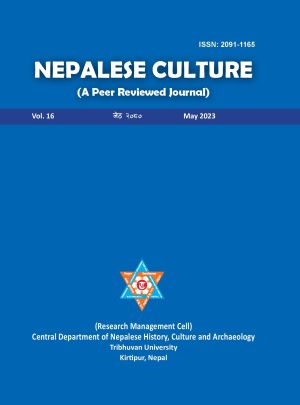यन्त्र संस्कृति र पशुपतिक्षेत्रका श्रीयन्त्रः एक विवेचना {Analytical Study of Yantra Culture and Shreeyantras of Pashupati Kshetra}
DOI:
https://doi.org/10.3126/nc.v16i1.54126Keywords:
Yantra, Tantra, Mantra, Shri-YantraAbstract
देवीदेवतालाई विविध यन्त्र स्वरूपमा पूजाआजा र आस्था प्रकट गर्ने परम्परा अत्यन्त प्राचीन परम्परा हो । विशेष गरेर तान्त्रिक देवीदेवतालाई यन्त्ररूपमा पूजा गरिन्छ र यन्त्रलाई पूजनको विशेष आधार वा अधिष्ठान मानिन्छ । प्रत्येक देवी–देवताका अलग–अलग यन्त्र हुनका साथै एउटै देवताका पनि ध्यान र मन्त्र भेदका कारण अलग–अलग यन्त्र हुने गर्दछन् । कहीं–कहीं यन्त्र र मूर्ति दुवै सँगैपनि स्थापना गरिन्छ । मन्त्र, तन्त्र र यन्त्रको एकअर्कामा अन्योन्याश्रित सम्बन्ध रहेको हुन्छ जुन क्रमशः यसप्रकार रहेको हुन्छः सर्वप्रथम मन्त्र, त्यसपछि तन्त्र र अन्त्यमा यन्त्र । मन्त्र मनमा मात्र उच्चारण गर्ने व्यक्त गर्न नहुने, तन्त्र मनभित्रको मन्त्रलाई तन (शरीर) को माध्यमले बाहिर प्रस्तुत गर्ने र यन्त्र वाहिर ल्याएको मन्त्रलाई राख्ने स्थान हो । यसप्रकार यन्त्र एक प्रयोगशाला जस्तै हो जहाँ देवताहरू अधिष्ठित हुन्छन् । शास्त्रहरूमा शरीर र आत्मा अभिन्न भए जस्तै यन्त्र र देवता पनि अभिन्न छन् र यन्त्र मन्त्रमय हुन्छ र मन्त्र देवतास्वरूप हुन्छ भनिएको पाइन्छ । यसरी नै मानव शरीरलाई पनि एक यन्त्रका रूपमा हेरिन्छ जहाँ शरीरको व्यवहारलाई तन्त्र र शरीरमा बसेर पलाउने विचारलाई मन्त्र मान्दै शरीरलाई एक यन्त्रका रूपमा लिइएको हो । यन्त्र विविध वस्तुहरूबाट निर्माण गरिएको हुन्छ र निर्माणका विधिहरू पनि फरक–फरक रहेका हुन्छन् भने प्राप्त हुने फल पनि अलग–अलग हुन्छन् । विविध यन्त्रहरू मध्ये श्रीयन्त्र पनि एक हो जसलाई श्रीचक्र, श्रीविद्या र यन्त्रराज पनि भनिन्छ र यस यन्त्रमा त्रिपुरासुन्दरीको उपासना गरिन्छ । पशुपतिक्षेत्रमा श्रीयन्त्र लगायत अन्य यन्त्रहरू पनि प्रशस्त रहेका छन् । यहाँ श्रीयन्त्र पशुपतिनाथको ईशान भागमा, जमिनमा, मन्दिरको गजुरमा, देवता माथि टाँगिएको चँदुवा आदिमा रहेका पाइन्छन् । यहाँ स्थायीरूपमा बनाएका श्रीयन्त्र वाहेक अस्थायी रूपमा प्रत्येक दिन पशुपतिनाथको ईशान भागमा र प्रत्येक पूर्णिमाका दिन गरिने पशुपतिनाथको महास्नानको क्रममा चढाइने भुजाको रासको पश्चिमी पाटोमा र सोही अवसरमा मन्दिरको दक्षिणी ढोकातर्फको सिँढीमा मूलभट्टले गोबरले लिपेर यसमाथि श्रीयन्त्र बनाई तान्त्रिक विधिले पूजा गर्दछन् । यहाँ अरू स्थायी रूपमा बनेका यन्त्रहरू मन्दिर लगायत बिभिन्न क्षेत्रहरूमा यत्र–तत्र निर्माण गरिएका छन् ।
{Deities have been worshipped in form of various Yantra (Symbolic Swaroopa or forms). It has gained great favor among Tantric deities. The Yantra( Symbols) have been given great value and importance. Different deities have had different Yantra (Symbols), in fact, one deity may possess on basis of different Dhyana (posture) and mantra (chanting) yantra (symbols) may also differ. In some places, both images and yantra symbols are installed in one place. Mantra (religious chanting), Tantra (magic), and Yantra (Symbolic swaroopa or forms) are related to one another. First comes the Mantra or chanting, then the tantra and last of all is the yantra. The mantra is chanted covertly, and the tantra is overtly displayed while the yantra is the symbolic fetish or place where the mantra and tantra are given a place to reside in a symbolic form. Therefore Yantra (symbolic swaroopa or form) is just like a laboratory where deities are placed. In the Sacred texts, it has been written that body and soul (Atma) is one; likewise, yantra and deities are also one. The Yantra (symbolic form) has a mantra (sacred chanting) and the mantra is deities themselves have been mentioned. Even the human body is a yantra (symbolic swaroopa or forms). Our physical behavior is Tantra and the ‘inner thinking’ is the mantra. Therefore, the body is considered as the yantra (symbolic swroopa or form). Yantra is made up of different materials, the making of Yantra differs and the blessings obtained vary. Among the yantras the “Shri Yantra” is considered the very important yantra, it is also known as “ShriChakra”, “Shri Vidhya”, or the YantraRaj. On this yantra deity, Shri Tripurasundari is worshipped. Within Pashupatinath Chetra or complex, there are “ShriYantra” as well as other yantras. Shri Yantra is on the Eshan Bhagh (upper part) of Shiva linga, on the Gajur or pinnacle, and on the Dwaja or Chadawa (hanging ornamented cloths or metal) one can see it. ShriYantra exists here permanently but everyday temporary yantras are made on the Eshan Bhagh of Pashupatinath and on the full-moon day when “Pashupati Maha-Snan” takes place on the western side of the “Mountain of Rice” and on the Southern side of the stairs of the Silver Doorway, the main priest or the Bhatta will clean the area with cow dung and prepare a yantra based on sacred mantra and tantra and on it, the worship is conducted. Here one can see many permanent yantras based on tantric mantras.}
Downloads
Downloads
Published
How to Cite
Issue
Section
License
© Central Department of Nepalese History, Culture and Archaeology, Tribhuvan University




